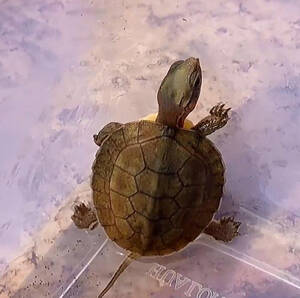Cuora mccordi
IUCN
LCBasic Information
Scientific classification
- name:Cuora mccordi
- Scientific Name:Cuora mccordi,Bose box terrapin,Mccord's Box Turtle,MacArthur's box turtle
- Outline:Testudines
- Family:Testudinidae B.turtle
Vital signs
- length:About 13 cm
- Weight:500-800g
- lifetime:20-30years
Feature
It is named after its origin near Baise City in Guangxi.
Distribution and Habitat
The Baise box turtle is endemic to China and is only distributed in Baise, Guangxi.
Appearance
The head is narrow, with a slightly protruding snout; the upper jaw is neither hooked nor notched. The carapace is up to 134 mm long (131 mm in males and 134 mm in females), oval, moderately convex; widest at the eighth marginal scutes and highest at the seam between the second and third vertebral scutes. The carapace has straight edges on both sides; there is a very small notch in the center of the rear edge. The front and rear edges of the carapace are usually turned up (more obvious in adults); the first marginal scutes are the widest, and the fourth to sixth marginal scutes are the smallest, with rough texture and growth rings. The nuchal scutes are rectangular to triangular, longer than wide; the fourth and fifth vertebral scutes are the widest; the rear edge of the vertebral scutes is prominent, and the front edge of the first vertebral scutes is prominent, reaching the seam between the first and second marginal scutes on the sides; the ridges on the second to fourth vertebral sc
Details
Bose box turtle is called Bose box terrapin in English, and has no subspecies.

The Baise Box Turtle was named by C.H Emst in August 1988 based on the specimens purchased from the west of Baise City, Guangxi, China, near the border of Yunnan. Because its origin is near Baise City, Guangxi, the Chinese name is Baise Box Turtle.
The Baise box turtle lives in mountainous areas and likes to live in mountain streams and ponds with clear water. It mainly feeds on animal food, such as snails, small fish and shrimps, and worms. When raised artificially, it likes to eat animal feed, such as lean pork, fish, shrimp, and snail meat. In an artificial environment, the Baise box turtle likes to move on moist land. It can actively eat above 18℃, and basically does not eat below 16℃, but often moves around. It completely enters a hibernation state below 10℃. 25-30℃ is the most active temperature range. It eats a lot, mainly small fish and shrimps, animal offal, lean meat, earthworms and various insects, and can also eat fruits.
The Baise box turtle lays eggs from May to August, 1 to 2 times a year, with 1 to 7 eggs per nest. The eggs are long and oval, and the hibernation period is from December to March of the following year.
The factors threatening the Baise box turtle include environmental pollution, habitat destruction and overhunting. Guangxi is a province with many forests, mountains and rivers. The industry is not very developed, and the development of various regions is very uneven. Only some sections of a few rivers in Guangxi suffer from relatively serious environmental pollution. The pollution level of most rivers is relatively light, and the environment of mountain streams is basically not affected by industrial pollution. Therefore, environmental pollution does not pose a serious threat to the survival of turtles. Although many mountainous areas are affected by vegetation destruction, resulting in a decline in the quality of turtle habitats, they can still meet the survival and reproduction of turtles. However, turtles in Guangxi are generally endangered, and some species have even become extinct in the wild. The main reason is undoubtedly overhunting. The people in mountainous areas are generally not well educated and have little awareness of protecting wild animals. The high market price of turtles strongly stimulates them to hunt. They basically do not distinguish between the species, gender and size of turtles, nor do they consider whether the turtles are in the breeding season. As long as they are found in the wild, they will be hunted. This "draining the pond to catch fish" hunting method has undoubtedly caused turtles to suffer a catastrophe.
Listed in the "Red List of Endangered Species of the World Conservation Union" (IUCN 2000 ver 3.1) - Critically Endangered (CR).
Listed in the "Convention on International Trade in Endangered Species of Wild Fauna and Flora" (CITES) - Appendix II.
Listed in the "China Biodiversity Red List - Vertebrate Volume" (Reptiles) - Critically Endangered (CR).
Listed in the "National List of Terrestrial Wildlife with Important Economic and Scientific Research Value" issued by the State Forestry Administration of China on August 1, 2000.
Protect wild animals and eliminate game.
Maintaining ecological balance is everyone's responsibility!








